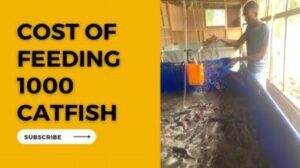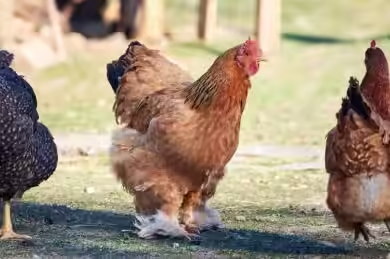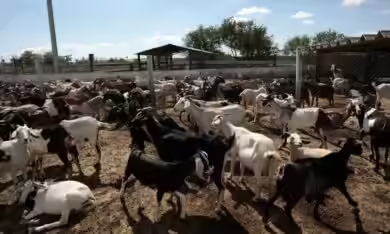Last updated on July 25, 2025
If you’re raising 1000 catfish, you know feed is your single largest expense, often representing up to 70% of your total operating costs. The most critical question for ensuring profitability is, “How do I accurately calculate and manage my feed?” Overspending eats into your profits, while underfeeding slows growth and harms your investment.
This guide provides a detailed breakdown for farmers operating at this semi-commercial scale. We’ll cover how to calculate feed based on biomass, estimate monthly bag requirements, analyze current costs, and explore smart strategies to reduce your overall feed expenditure.
Note: This guide is for a semi-commercial scale. If you’re just starting with a smaller backyard pond, you might find our guide for feeding 500 catfish more suitable for your needs.
How to Calculate Catfish Feed Accurately (The Biomass Method)
For a 1000-fish operation, simple guesswork isn’t enough. The most reliable method is bodyweight-based feeding, which adjusts as your fish grow. The formula is:
Daily Feed Amount = (Total Fish Weight) x (Feeding Rate % / 100)
- Total Fish Weight (Biomass): The average weight of one fish multiplied by the total number of fish (1000).
- Feeding Rate %: The percentage of their body weight fish should eat daily. This percentage decreases as fish get bigger (e.g., 5-10% for fingerlings, 2-3% for adults).
Example Calculation: You have 1000 catfish with an average weight of 150g (0.15kg). The feeding rate for this size is 3%.
- Calculate Total Fish Weight:
1000 fish x 0.15 kg/fish = 150 kg - Calculate Daily Feed:
150 kg x (3 / 100) = 4.5 kg of feed per day
Regularly sampling your fish (every 1-2 weeks) to update the average weight is essential for this method to be effective.
How Many Bags to Feed 1000 Catfish Monthly?
Let’s use our daily feed calculation to estimate monthly bag requirements.
- Monthly Feed (in kg):
4.5 kg/day x 30.4 days (average days in a month) = 136.8 kg
Now, convert this to standard 15kg feed bags:
- Bags Needed:
136.8 kg ÷ 15 kg/bag = 9.12 bags.You should budget for 10 bags per month for fish at this specific size.
As your fish grow towards market size, their daily feed intake might increase to 12kg or more, requiring over 24 bags (364.8 kg) per month.
How Much Does It Cost to Feed 1000 Catfish? (2025 Price Estimate)
Feed prices in Nigeria vary by brand, quality, and protein content. Floating feed is generally more expensive than sinking feed.
Nigerian Catfish Feed Price Table (per 15kg Bag, April 2025 Estimate)
| Brand | Typical Price Range (₦) | Price per KG (₦) |
|---|---|---|
| Bluecrown / Ecofloat | ₦28,000 – ₦35,000 | ₦1,867 – ₦2,333 |
| TopFeed Aqua / Vital | ₦31,000 – ₦39,000 | ₦2,067 – ₦2,600 |
| Aller Aqua / Skretting | ₦38,000 – ₦58,000+ | ₦2,533 – ₦3,867+ |
Total Monthly Feed Cost Example (Juveniles):
Using our 136.8 kg monthly feed requirement and an average mid-range feed cost of ₦2,300/kg:
- Total Monthly Cost:
136.8 kg x ₦2,300/kg = ₦314,640
This cost will increase as the fish grow larger and consume more feed. For a comprehensive overview of all fish farming startup and operational costs, see our Fish Farming Startup Costs in Nigeria (A Realistic 2025/2026 Budget) guide.
Factors Affecting Your Feed Requirements
- Feed Conversion Ratio (FCR): The key measure of efficiency. It’s the amount of feed needed to produce 1kg of fish weight. A lower FCR (e.g., 1.2) is better than a higher one (e.g., 1.8). High-quality feed and good water management lead to a better FCR.As experts from MediaNgr.net point out, “The Feed Conversion Ratio (FCR) indicates the amount of feed required to produce a specific fish weight. It measures the effectiveness of feed use. Monitoring this parameter is crucial as it decides the feasibility of the feed-based enterprise’s production systems. For the most economical option, use feeds with a proven FCR of no more than 1.2:1.” [Source: MediaNgr.net]
- Stocking Density: Overcrowding increases stress and competition, worsening FCR and slowing growth.
- Water Quality: Fish in clean, well-oxygenated water (Temp: 26°C-30°C, DO: >5 mg/L) have better appetites and utilize feed more efficiently.
The 1000-Fish Farmer’s Feeding Checklist:
✓ Calculate with Biomass: Stop guessing. Weigh your fish bi-weekly and use the bodyweight formula. ✓ Track Your FCR: Know exactly how many kg of feed it takes to produce 1kg of fish. Aim for 1.5 or lower. ✓ Optimize Water Quality: Don’t let poor water conditions waste your expensive feed. ✓ Use Feeding Trays: Monitor consumption and prevent waste, especially with sinking feeds.
Smart Ways to Reduce Catfish Feed Costs
Catfish farming can be profitable, but feed costs often eat up a huge chunk of your expenses. So, what if you could shrink that expense? Here are some savvy strategies to help you cut those feed costs without compromising.
- Improve FCR Through Pond Management: The best way to save money on feed is to ensure none of it is wasted. Maintain excellent water quality and don’t overcrowd your ponds.
- Use Feeding Trays: These prevent sinking feed from getting lost in the mud, allowing you to monitor consumption accurately and reduce waste.
- Avoid Common Mistakes: Do not overfeed, as this pollutes the water. Pay close attention to your fish’s feeding response; if they aren’t eating eagerly, reduce the amount and check your water quality.
- Consider Homemade Feed Carefully: While it can seem cheaper, making your own feed is labor-intensive and carries a high risk of nutritional imbalance, which can lead to poor growth and a higher FCR, costing you more in the long run. For a 1000-fish scale, sticking to reliable commercial feed is often more economically sound. For more on producing alternative feeds, explore our guide on How to Produce Maggots for Catfish Farming.
Conclusion: Plan, Monitor, and Adjust
Feeding 1000 catfish successfully marks the transition from fish keeping to a data-driven agricultural business. Your most important tools are no longer just a bucket and a scoop, but a scale, a calculator, and a record book. By meticulously calculating your feed based on biomass, relentlessly tracking your FCR, and optimizing your pond’s efficiency, you can take command of your biggest operational cost and pave the way for a more profitable harvest.
FAQs: Feeding 1000 Catfish
What is the Feed Conversion Ratio (FCR) and why is it important?
FCR measures how efficiently fish convert feed into weight. A lower FCR means better feed utilization, which directly impacts your farm’s profitability by reducing costs.
How often should I feed 1000 catfish?
Feeding frequency depends on their growth stage. Younger fish may need 3-4 times daily, while older fish can be fed 2-3 times daily. Consistency is crucial.
What is the biggest cost in raising 1000 catfish?
Feed is typically the largest expense, often accounting for 60-70% of total operational costs in a catfish farming operation.
How can I reduce feed costs for 1000 catfish?
Focus on improving FCR through optimal water quality, proper stocking density, using feeding trays, and avoiding overfeeding. Researching quality local feed brands can also help.


